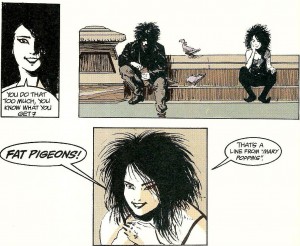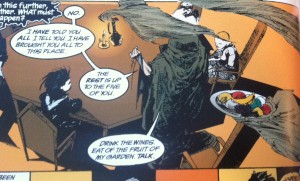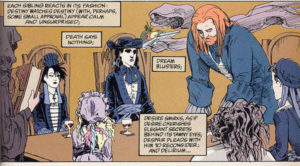Family is a fluid term. The most obvious way to define who is a family member is determining whether you have blood and genes in common. But, your partners count as family and so can your friends. Some families have two parents, some families have children, some don’t. The Endless don’t fit into the average definition of the word by any means, but they are brothers and sisters nonetheless. They fight, give advice to each other, help lift spirits, cause trouble, and all the things you’d expect siblings to do – they just happen to be extremely powerful. Also ageless and immortal. They aren’t gods, but they’re close.
Destiny, Death, Dream, Destruction, Despair, Desire and Delirium. You could make fun of them for being one of those families where every name begins with the same letter, but I wouldn’t recommend it.
We meet Dream, a.k.a. The Sandman a.k.a. Morpheus, first in this series and spend the most time with him. The comic is called The Sandman after all. Death comes along eight issues into the run in “The Sound of Her Wings” and turns all preconceptions you might have about the entity on its head. In short, she is the delightful sort of being you just want to put in your pocket to keep her by your side. For goodness’ sake, she quotes Mary Poppins to her dismal brother.
She’s only around for twenty-some pages, but it’s abundantly clear her and Dream are close. Maybe not talk on the phone every day close but definitely the kind of close that means they can always connect with ease, even if they haven’t communicated in months or years. Death can get through to him. Of all the Endless, she seems to know him the best.
The full family comes into the pages together in issue 21, “Season of Mists: A Prologue.” Destiny, the eldest, summoned his siblings through his gallery of paintings. None of the group is pleased to be there; the awkward seeps through the pages. Typical family gathering.
Even with the uncomfortable undertones, issue 21 is a must read. After the Endless arrive, a three page spread with introductions follow. You learn more about each sibling than you have before and the bios give insight into their interactions on the following pages. When Delirium randomly interrupts to point out that she made butterflies, you don’t necessarily understand it, but you’re not surprised. She’s the youngest of the Endless and I often interpret her actions as need for attention. The rest of her siblings tend to ignore her comments and questions and talk as if she hadn’t said a thing. Desire even bullies her.
Desire shows off her power with Dream, too. She needles him into leaving the room while Death, capable of “real talk” with Dream, tells him Desire was right. She’s able to make him see the truth and at the end of, we see Dream is a being committed to righting a wrong. They’re fascinating. The amount of relationship cues, character hints, and complex layers packed into the issue are impressive.
Just like other families, there’s a brother who tires of the family business. Destruction has abandoned his post. The Endless note his absence at the gathering in “Seasons of Mist.” Destruction moderates creation. No cities or countries fall when he quits being Destruction, it’s just not as controlled. He shakes things up not only by leaving but by showing the Endless that they are not necessary for the world to keep turning. Dream and Delirium seek him out in issue 47, “Brief Lives: Chapter Seven.”
It’s been 300 years. Watching Delirium’s reaction to finding him is the best part of the issue. Little sister missing a big brother – endearing as hell and that’s not often a word which goes with the disturbed Delirium. They try in vain to get Destruction back to his post, but he has embraced his role as the black sheep. He served for over ten billion years. Destruction explains to them that the Endless aren’t needed, like a shop that has been open past its prime and sells product no one wants. He leaves his family behind. It happens.
Though the problems they have to face are often extraordinary, Gaiman gives the Endless human qualities. While it would be easy to write them in a way that makes them so far beyond us that we can’t relate to them, the story isn’t lazy. You can put yourself in their shoes and therefore feel more strongly attached to them. When they gather around the table in “Seasons of Mist,” it reminded me of sitting at the table with my family at the holidays. Bickering and teasing but underneath all of it, begrudging affection – well, from some of them. These immortal beings display the right amount of human parallels to make you care.




Comments are closed.